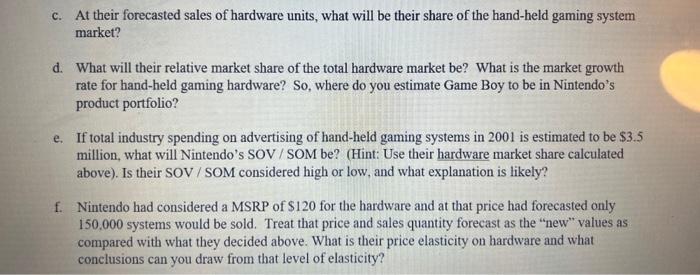Answered step by step
Verified Expert Solution
Question
1 Approved Answer
The questions are letter C,D,E & F. Please help! In 2001, Nintendo Canada was launching its new Game Boy Color hand-held gaming system with the
The questions are letter C,D,E & F. Please help! 

In 2001, Nintendo Canada was launching its new Game Boy Color hand-held gaming system with the following pricing and cost structure for hardware and software (cartridges). The manufacturer's suggested retail price (MSRP) on the hardware units would be $100 with a retail trade margin of 8% of the retail selling price and a wholesale trade margin of 5% of the wholesale selling price. Margins were tight on the hardware because software was where the money was made. Software cartridges would sell at retail for $43 with a retail margin of 20% and a wholesale margin of 40%. During the launch year, Nintendo planned to sell only direct to large retail accounts and therefore Nintendo would be receiving the wholesale price for both hardware and software. They forecast sales of 200,000 hardware units and 600,000 software cartridges in the first year. The total Canadian market for hand-held gaming systems next year was estimated to be 300,000 hardware units (up from 250,000 last year) and 800,000 cartridges (up from 700,000 last year). That compares with a market growth rate of just 5% for console systems. Their largest competitor, Sega Game Gear, had 15% of the market for hand-held gaming hardware and 15% of the software market as well. Nintendo's marketing budget for the launch year included $3 million for advertising. $1.3 million for consumer sales promotion (sampling, contests, and cross promotions), and $400,000 for trade promotion (point of sale materials). Ten percent of Nintendo Canada's $12 million fixed overhead would be allocated to the Game Boy division and that would include allowances for management salaries. c. At their forecasted sales of hardware units, what will be their share of the hand-held gaming system market? d. What will their relative market share of the total hardware market be? What is the market growth rate for hand-held gaming hardware? So, where do you estimate Game Boy to be in Nintendo's product portfolio? e. If total industry spending on advertising of hand-held gaming systems in 2001 is estimated to be $3.5 million, what will Nintendo's SOV / SOM be? (Hint: Use their hardware market share calculated above). Is their SOV / SOM considered high or low, and what explanation is likely? f. Nintendo had considered a MSRP of $120 for the hardware and at that price had forecasted only 150.000 systems would be sold. Treat that price and sales quantity forecast as the "new" values as compared with what they decided above. What is their price elasticity on hardware and what conclusions can you draw from that level of elasticity 

Step by Step Solution
There are 3 Steps involved in it
Step: 1

Get Instant Access to Expert-Tailored Solutions
See step-by-step solutions with expert insights and AI powered tools for academic success
Step: 2

Step: 3

Ace Your Homework with AI
Get the answers you need in no time with our AI-driven, step-by-step assistance
Get Started


